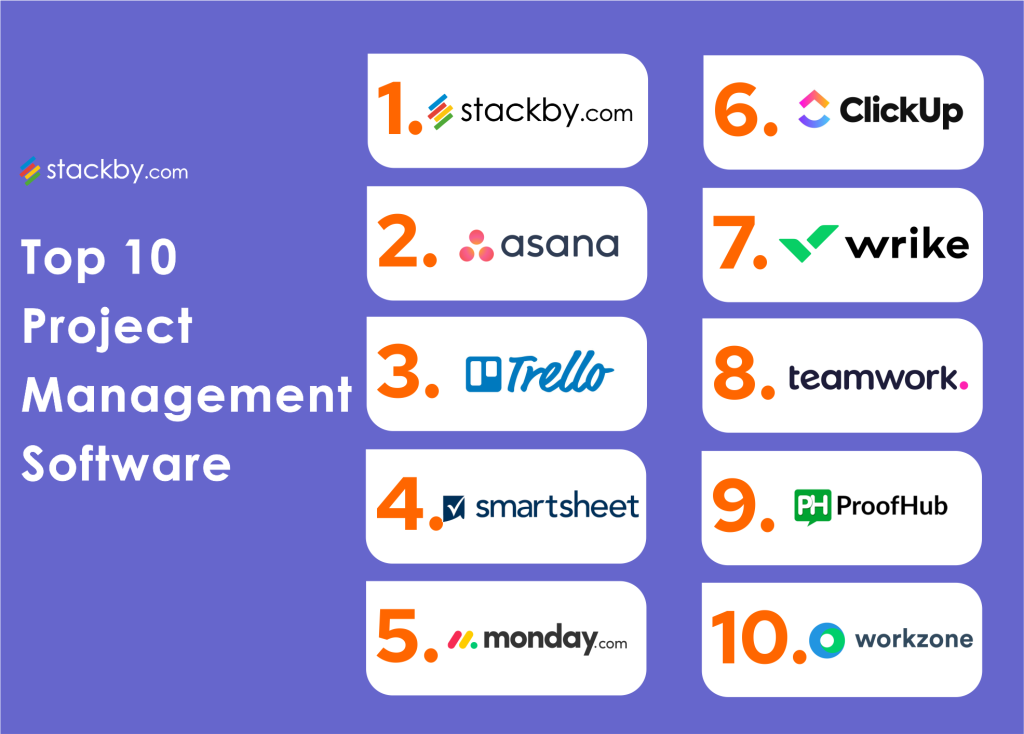With so many project management software options to choose from, it can seem daunting to find the right one for your projects or company. We’ve narrowed them down to these ten.
We may be compensated by vendors who appear on this page through methods such as affiliate links or sponsored partnerships. This may influence how and where their products appear on our site, but vendors cannot pay to influence the content of our reviews. For more info, visit our Terms of Use page.
Project management software helps individuals and companies organize tasks, projects, and sets of projects. These tools increase visibility for all team members and stakeholders, and ensure that tasks don’t get neglected in the shuffle. While project managers and IT professionals use project management apps most frequently, the software should be accessible and easy to use for all team members of different tech backgrounds.

Top project management software
I’ve reviewed each of these ten project management platforms to understand their capabilities and ease of use for an IT project. TechRepublic’s top picks for project management software are listed below. You’ll also find a link to the full review accompanying each of the overviews listed here.
The monday.com Work OS is a reputable project management brand with a flexible platform for teams of all flavors. While initially intimidating, the monday.com interface is packed with features and offers extensive configuration management capabilities. While other solutions lean into a few views of project data, monday.com gives users the most flexibility in adding and configuring valuable visualizations.

Though I ran into hiccups using monday.com, the PM software excels in configurability, giving teams the expected control to optimize workflows.
Visualize project data through multiple table, Kanban, and dashboard views.
Personalize colorful interfaces that bring project data to life.
Customize and share surveys for data collection via the WorkForms tool.
Access integrations for developers, marketing, CRM, and project management.
Pre-built automations and a long list of options for creating automation rules.
Pros of monday.com
Clean user interface not bogged down by the platform’s extensive features.
Robust configurability for setting the workspace and tools to team specifications.
Designed for a multitude of use cases across industries and functions.
Cons of monday.com
An evident learning curve for new users and implementing advanced features.
Import engine failed to pull most existing data into the platform.
Manually inputting data to reconcile import was the biggest pain point.
SEE: monday.com Work OS review (TechRepublic)

Launched in 2005, Smartsheet’s project and work management platform is one of the safest bets in the PM software market. From onboarding to using the platform, I was impressed by the interface’s user-friendliness and the features’ extensibility. Smartsheet offers an upgrade from traditional tools by adding accessible UX, needed integrations, robust configurability, and no-code capabilities to a spreadsheet interface.
Smartsheet pricing is among the highest in the market, and there is no unlimited free plan. Still, I believe the platform’s benefits more than justify consideration for small teams up to enterprise organizations.
Add comments, attachments and proofs to rows, or expand and condense tasks to view project details in Smartsheet’s Grid view.
Features of Smartsheet
Create, import, and manage project data in a central cloud-based platform.
Visualize project data through Grid, Gantt, card, and calendar views.
Flexible options for setting and adjusting project field data.
WorkApps, the platform’s no-code tool for building web and mobile apps.
Activity log for tracking change management with filters to identify actions.
Pros of Smartsheet
Friendly user interface for moving from legacy spreadsheet tools.
Extensive documentation and access to onboarding assistance.
Pre-built project and automation templates to get to work fast.
Cons of Smartsheet
Several tools are add-ons requiring an additional purchase.
Security features limited to the Enterprise subscription.
Premium support only available for higher tier plans.
SEE: Smartsheet review (TechRepublic)
SMARTSHEET
ClickUp: Best for teams on a tight budget
The fastest mover in the project management software space is ClickUp. Only five years after its founding, the San Diego-based startup has grown into one of the top PM solution providers. ClickUp far exceeded my expectations with a stack of project views and tools to enable productivity and collaboration for a wide variety of functional teams.
Add in that ClickUp offers a handful of affordable subscriptions for different team sizes, and it’s difficult not to consider the market’s budding PM software.
The List view in ClickUp allows users to bulk edit multiple tasks.
Features of ClickUp
Visualize project data through List, Board, Gantt, Calendar, Workload, and Map views.
Create and modify tasks or bulk edit tasks from a list of potential operations.
Manage granular configurations of platform features and security.
Track and visualize project data through the Dashboards view.
Import data from monday, Asana, Trello, Jira, Wrike, Basecamp, and Todoist.

Pros of ClickUp
Widest and most affordable range of plans to meet different-sized team needs.
Robust configurability for customizing and managing platform workflows.
Access to over 1,000 integrations for developers, business suites, storage, and more.
Cons of ClickUp
Slight variance between imported file and platform results.
Some platform actions are less intuitive and require additional troubleshooting.
Occasional lagging between moving pages and lingering platform notices.
SEE: ClickUp review (TechRepublic)
CLICKUP
Teamwork: Best for time tracking and budgeting
As the name implies, Teamwork is project management software that enables team and workload management. The Ireland-based platform offers a similar range to other top PM solutions but excels in time tracking, budgeting and stakeholder management. Whether it’s personnel or a third-party contractor, Teamwork is fit for optimizing the globally distributed workflows of tomorrow.
While a few actions during my experience with Teamwork didn’t seem as intuitive as other platforms, the platform and its potential to organize team projects are impressive.
The dashboard view in Teamwork automatically breaks down project data and metrics.
Features of Teamwork
Visualize project data through Gantt, Kanban, calendar, and table views.
Build and generate reports of project data to share via CSV, Excel, or PDF.
Create project templates, dashboards, risks, and project level tags for re-use.
Integrations with Zapier, Google Drive, Box, Slack, Microsoft, HubSpot, and more.
Built-in Teamwork apps for collaborative spaces, IT help desks, CRM, and web chats.
Pros of Teamwork
Strongest time tracking and workload management capabilities of the products I reviewed.
Deep range of features emulating the best in the PM software market.
Free 30-day trial, an unlimited free plan, and affordable annual subscriptions.
Cons of Teamwork
Basic agile support and burndown reports are only available with higher plans.
Configure notification settings or get ready for a full inbox.
Modifications sometimes took several seconds to load.
SEE: Teamwork review (TechRepublic)
TEAMWORK
Wrike: Best for portfolio management
The newest subsidiary of Citrix, Wrike was already one of the biggest names in project management software even before its backing by the cloud computing giant. With the capacity to manage entire project portfolios, Wrike’s feature set includes custom request forms, risk predictions, invoicing software, and enterprise-grade security. I found the platform incredibly powerful, with clear use cases for small businesses, enterprise organizations, and various team functions.
Upon first glance, the user interface is busy, and Wrike’s learning curve is likely the steepest in the PM software space. That said, few vendors offer the same extent of enterprise capabilities.
No matter the view, users can open task details to view, edit, or attach data for team visibility.
Features of Wrike
Visualize project data through table, list, board, Gantt, timelog, and analytics views.
Add and edit task duration, approvals, time entries, subtasks, files, and dependencies.
Project templates for Agile, creative, IT operations, and PM office teams.
Customer-managed encryption keys and external encryption key storage via AWS.
Access to over 400 app integrations and two-way sync with almost 30 other apps.
Pros of Wrike
Plans for teams managing complex workloads, marketing, and professional services.
Extensive interoperability and workflow capabilities with business critical applications.
Enterprise-ready with premium security and data privacy controls.
Cons of Wrike
More expensive than most PM solutions.
Steep learning curve for maximizing extent of platform features.
Several tools are only available as an add-on feature or a higher subscription.
SEE: Wrike review (TechRepublic)
WRIKE
Asana: Best for extensibility
One of the most popular PM software solutions, Asana is the work management platform started by former Facebook developers in 2008. The Silicon Valley-based company has grown dramatically in that time, and the platform’s extensibility affirms why so many businesses choose it. From viewing team member workloads to adding strategic goals and setting user security policies, I believe Asana has something for every team.
Though some actions were less intuitive, Asana made up for them with the documentation and resources to guide platform projects efficiently.
The List view in Asana looks similar to a spreadsheet and allows users to view, modify, or communicate through task details.
Features of Asana
Visualize project data through list, board, timeline, calendar, and workload views.
Manage and create project data with custom fields, rules, and forms.
Enable the built-in time tracking tool to visualize time spent on tasks.
Import data from Airtable, Google Sheets, monday, Trello, Smartsheet, or Wrike.
Access to integrations for communications, files, finance, IT, reporting, sales, and security.
Pros of Asana
Robust feature set that competes with the best in the PM software space.
Friendly user interface and flexible controls for different tools.
Extensive import options, including multiple top PM platforms.
Cons of Asana
At times, the interface is less intuitive than competing PM platforms.
Steep learning curve for deploying some features and advanced tools.
Occasional error messages and lagging when moving between platform pages.
SEE: Asana review (TechRepublic)
ASANA
Airtable: Best for granular controls
A decade after its founding, Airtable has raised over $1.4 billion to develop a PM software solution. After using it myself, I can attest it’s been money well-spent. Behind its friendly interface, Airtable is a powerful platform offering teams granular control over extensions, scripts, and workflows to optimize process management.
While the newest platform tool, the Interface Designer, struggled to maintain a server connection during use, I was impressed by my experience with Airtable.
The Gantt view on Airtable provides teams with tasks layered over a timescale.
Features of Airtable
Visualize project data through grid, Kanban, gallery, Gantt, and calendar views.
Build an internal or external app with the Interface Designer.
Integrate, sync, and consolidate data from Google, Salesforce and Jira to Airtable.
Deploy pre-built and custom automations with granular control over rule scripting.
Access to 40 Airtable-developed extensions, 20 scripts, and 150 open source apps.
Pros of Airtable
Most accurate and seamless import process among PM tools tested.
Clean and intuitive user interface for exploring and utilizing the platform.
Capabilities for small teams up to enterprise organizations.
Cons of Airtable
Limited extensions for many of the subscription plans.
Occasional lagging when moving between data-involved views.
Fewer enterprise integrations than other top PM tools.
SEE: Airtable review (TechRepublic)
AIRTABLE
Zoho Projects: Best for multiple project visualizations
Under the Zoho portfolio of solutions, Zoho Projects offers teams a stack of features for tracking tasks, issues, time, and resources to maximize collaboration and productivity. Users can visualize and adjust project data through views like a traditional spreadsheet, simple list, Kanban board, or Gantt chart in real time or automate mapped workflows with the Blueprints tool.
Zoho Projects offers a lot of functionality, considering it’s the most affordable PM software. However, it also lacks some of the configurability and advanced features included in the top tier of platforms.
Users can add, modify, move, and delete tasks via row icons within Zoho Projects.
Features of Zoho Projects
Visualize project data through Classic (spreadsheet), Plain (List), and Kanban views.
Create project baselines to compare expected vs. real progress on tasks.
Time tracking of tasks to inform workload and resource management.
Integrations with critical apps for Google, Microsoft, code repositories, and more.
Access to Zoho Apps like Mail, Docs, CRM, Desk, Analytics, and Forms.
Pros of Zoho Projects
Least expensive subscription plans among the top PM platforms.
Robust feature set considering its affordability.
Familiar interface and bundling value for existing Zoho customers.
Cons of Zoho Projects
Lagging when moving between different platform pages.
Limited options for viewing project data relative to competitors.
Some platform actions like creating multiple subtasks aren’t intuitive.
SEE: Zoho Projects review (TechRepublic)
ZOHO PROJECTS
Zenhub: Best for GitHub integrations
Likely the least familiar pick, Zenhub’s native integration with GitHub gives the project management software solution a distinct advantage. Project managers unfamiliar with GitHub have a mighty learning curve, but developer teams will love the ease of managing and visualizing data through a familiar interface.
Zenhub supplements the world’s leading repository with tools like planning poker, a sprint generator, workflow automation, and reporting to make the most of GitHub project management.
